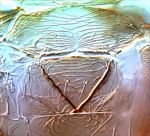
rubrocinctus male & female

rubrocinctus head & thorax

rubrocinctus antenna

rubrocinctus meso & metanota

rubrocinctus tergites VII-X

rubrocinctus fore wing
Generic diagnosis
Female macropterous. Head wider than long, strongly reticulate, not projecting in front of eyes; ocellar region elevated, occipital ridge absent, cheek constricted at base; three pairs of postocular setae; maxillary palps 2-segmented. Antennae 8-segmented, segment I without paired dorso-apical setae; III with sense cone forked, IV with one forked and one simple sense cones. Pronotum with transverse reticulation, no long setae. Mesonotum entire, transverse, anteromedian campaniform sensilla present. Metanotum weakly reticulate medially, with triangle, median setae behind anterior margin, campaniform sensilla present. Fore wing anterior margin fringe cilia shorter than costal setae; first and second veins with complete rows of long setae; clavus with four veinal but no discal setae; posterior margin fringe cilia wavy. Prosternal ferna divided; basantra membranous and without setae; mesosternal endofurca without spinula, metasternal endofurca narrowly U-shaped slightly extending toward mesosternum. Legs without reticulation, tarsi 1-segmented. Tergites with entire craspedum, II-VIII reticulate laterally and on anterior median area; VIII with complete comb; IX with two pairs of campaniform sensilla; X median split complete. Sternites with entire craspedum; II–VII with three pairs of posteromarginal setae; VII with two additional small setae.
Male sternites III–VII each with one small pore plate.
Biological data
Known as the Red-banded Thrips on account of the colour of the larvae, the Cacao Thrips is a polyphagous leaf-feeding species that is usually found breeding on older leaves, sometimes in association with leaf damage.
Distribution data
The single species in the genus Selenothrips is widespread in tropical countries around the world, although presumably it came originally from Africa.
Nomenclatural data
Heliothrips (Selenothrips) Karny, 1911: 179. Type species Physopus rubrocincta Giard 1901, by monotypy.
Only one species is placed in this genus (ThripsWiki, 2020), and this is recorded from southern China:
rubrocinctus (Giard, 1901: 263). (Physopus)
Relationship data
Thripidae sub-family Panchaetothripinae: this group is represented widely around the world, particularly in tropical areas, and comprises about 40 genera. This is one of seven genera from Africa that appear to form a distinct clade within the Panchaetothripinae (Mound et al., 2001).
References
Mound LA, Marullo R & Trueman JWH (2001) The greenhouse thrips, Heliothrips haemorrhoidalis, and its generic relationships within the sub-family Panchaetothripinae (Thysanoptera; Thripidae). Journal of Insect Systematics and Evolution 32: 1–12.
ThripsWiki (2020) ThripsWiki - providing information on the World's thrips. <http://thrips.info/wiki/Main_Page>